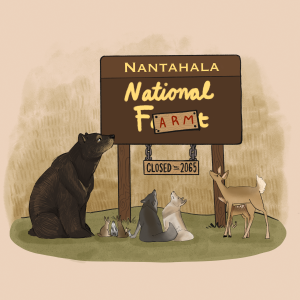App State alumnus discovers new tyrannosaur species
April 16, 2020
App State alumnus Jared Voris discovered a new tyrannosaur species and gained worldwide media attention.
Voris was studying one afternoon for his master’s thesis at the University of Calgary in Alberta, Canada. While studying, he stumbled across some unusual skull fragments at his desk. The one thing that stood out to Voris that day was the uniqueness in the dinosaur’s jawline. Voris never saw anything like this before. Voris quickly told his thesis professor about the fossils.
Voris said he understood that discovering Thanatotheristes degrootorum is a remarkable discovery, but he wasn’t ecstatic about the discovery until the name of the tyrannosaur was released.
“It was interesting to see the way my discovery took off. The big part of it was the name of the animal,” Voris said. “People would ask, ‘How did I come up with the name?’ But I wasn’t the one who came up with the name. One of my colleagues here at Calgary did.”
Voris said his colleague, Amanda Hendrix, created the name. Just like Voris, Hendrix is an App State alumna pursuing a master’s degree at the University of Calgary.
“I asked her, ‘what are some interesting names that we can come up with for a tyrannosaurus?’ She came up with the name Thanatotheristes, which translates into ‘The Death Reaper,’” Voris said. “It’s a fun name.”
According to the National Geographic, Thanatotheristes degrootorum ages around 79.5 million years. The tyrannosaurus stands at 8 tall, 30 feet long and ate meat for survival.
Voris said one thing that sets these creatures apart from any other tyrannosaurus is the skull fragments.
“Vertical ridges in the jawline are important for two reasons. The shape was something we had never seen before, so it’s unique to that specific species,” Voris said. “There is one group of tyrannosaur who are somewhat similar but not quite. Those animals are some of the largest animals to walk the Earth.”
Voris said T-Rex is one of few tyrannosaur species that looks closely related to Thanatotheristes degrootorum. The discovery broadens paleontologists’ and Voris’ understanding of how other tyrannosaurs in similar categories evolved.
“Some of the other characteristics are jugal bone. The jugal bone sits below the eye socket. If you were to cut the jugal bone in half and display CT scans of the cross-section, you’ll see that the bone is an oval shape,” Voris said.
Voris said the top of the bone has a rounded margin, whereas other species, with the same margin of bone have a prominent blade-like tabor edge. There were other characteristics that Voris named like a crest on the top of the skull. The interlocking bony projection of the inside of the lower jaw is another characteristic. Voris said the difference in the interlocking strengthens the joint.
Voris grew up with a “burning passion” for fossils, and was always fascinated with dinosaurs.
“My mother said my first love for dinosaurs was Barney, I love going outside catching lizards, snakes, frogs, those sort of things,” Voris said.
Voris’ fascination for ancient times grew and transferred to college. He combined his passion for dinosaurs with science and earned a bachelor’s degree at App State. He said he couldn’t have done it without his professor, Andy Heckert, in the geological and environmental science department.
“He was influential in teaching me what paleontology meant. My involvement helped me realize how fun, but challenging it is. I always enjoyed those kinds of challenges,” Voris said. “He pushed me to continue and invest in research projects to learn the ropes.”












